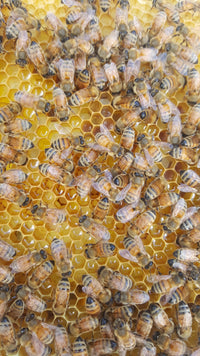Honey, nature's liquid gold, undergoes an intriguing natural process known as crystallization. Far from being a sign of spoilage, crystallization is a hallmark of high-quality, pure honey. However, misconceptions abound, with many consumers preferring liquid honey, as typically found in large grocery chains. This preference has led to the adulteration of honey, diluting its natural essence and benefits. Let’s explore the science behind crystallization, how it varies among different honey types, and why SAVAGE BEE-CHES® honey stands superior in quality and authenticity.
Honey crystallization occurs when glucose, one of honey's primary sugars, spontaneously precipitates out of the supersaturated honey solution. Temperature, the ratio of glucose to water, and the presence of nucleation points, such as pollen grains, influence this natural process. Cooler temperatures and higher glucose content accelerate crystallization.
Different honey varieties crystallize at different rates due to their unique sugar compositions. For example, clover and alfalfa honey, high in glucose, crystallize quickly, while acacia and sage honey, with higher fructose levels, remain liquid longer. The presence of tiny particles, like pollen, also catalyzes crystallization, acting as a foundation for glucose crystals to form.
The Superiority of SAVAGE BEE-CHES® Honey: Unlike honey found in large chain grocers, which is often adulterated to prevent crystallization, SAVAGE BEE-CHES® prides itself on offering pure, unadulterated honey. The common industry practice of diluting honey with syrup to reduce glucose content or using high filtration to remove pollen compromises honey's natural qualities. In contrast, SAVAGE BEE-CHES® honey celebrates its crystallization as a testament to its purity and naturalness, ensuring customers enjoy honey as nature intended.
Around the world, crystallized honey is not just accepted but cherished for its spreadable texture and rich flavor. It’s a preferred form in many cultures for its ease of use and versatility in recipes.
Enjoying Crystallized Honey: Crystallized honey can be enjoyed in many ways, from spreading on toast to stirring into oatmeal, offering a delightful texture and taste. Moreover, it serves as the base for making creamed honey, a popular product enjoyed globally. By whipping equal parts of liquid and crystallized honey, you can create creamed honey with a smooth, spreadable consistency – a simple yet delicious transformation.
Creating Creamed Honey with SAVAGE BEE-CHES®: With SAVAGE BEE-CHES® honey, creating your creamed honey is effortless. Our diverse range of honey varieties, from clover to sage, allows for a myriad of flavors for your creamed honey, ensuring a gourmet experience that stands apart from mass-produced options.
Honey crystallization is a natural process that signifies purity and quality. At SAVAGE BEE-CHES®, we embrace this natural phenomenon, offering our customers honey that is as authentic as it is delicious. By choosing SAVAGE BEE-CHES®, you're not only enjoying honey in its most natural form but also supporting sustainable practices that respect the integrity of this precious resource.



Leave a comment